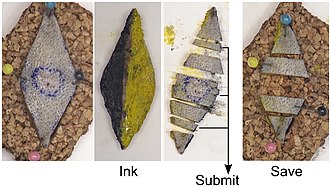Difference between revisions of "Unoriented skin ellipse grossing"
Jump to navigation
Jump to search
(+image) |
|||
| Line 1: | Line 1: | ||
[[Image:Grossing of suspected malignant skin excision.jpg|thumb|300px|Unoriented skin ellipse specimen at cut-up. (WC/Mikael Häggström)]] | |||
The article deals with small '''unoriented skin ellipse grossing'''. | The article deals with small '''unoriented skin ellipse grossing'''. | ||
Latest revision as of 19:11, 5 December 2023
The article deals with small unoriented skin ellipse grossing.
Punch biopsies and oriented skin ellipses are dealt with separately.
Introduction
These specimens are very common.
Protocol
- Name and patient identifiers on the requisition match the specimen container.
- Specimen labelled as: "[ ]".
- Specimen received in: [formalin/fresh].
- Type: unoriented portion of skin measuring [ ] x [ ] cm (in the plane of surface), by [ ] cm (depth).
- Inking: resection margin blue. †
- Lesion: [ brown ] colour, [ diffuse / patchy] with a [ regular / irregular ] border.
- Lesion dimensions: [ ] x [ ] cm (in the plane of surface), by [ ] cm (depth).
- Margins: [ ] peripheral cm, [ ] deep cm.
Serially sectioned with cuts perpendicular to the long axis:
- Block A1 - tips.
- Block A2 - remainder of specimen.
Protocol notes
- † One should avoid black ink if there is any suspicion of melanoma or if the lesion is pigmented. This can be remember by black is bad and green is good!
- In general, green and blue are the preferred marking ink colours as they are easier to see at the time of embedding.[1]
Alternate approaches
See also
Related protocols
References
- ↑ Lester, Susan Carole (2010). Manual of Surgical Pathology (3rd ed.). Saunders. pp. 312. ISBN 978-0-323-06516-0.
